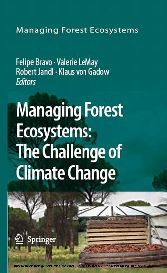
Managing Forest Ecosystems: The Challenge of Climate Change

von: Felipe Bravo, Valerie LeMay, Robert Jandl, Klaus von Gadow
Springer-Verlag, 2008
ISBN: 9781402083433
Sprache: Englisch
333 Seiten, Download: 4757 KB
Format: PDF, auch als Online-Lesen
Introduction (p. 3-4)
F. Bravo, R. Jandl, K. V. Gadow, and V. LeMay
1 Forest Management and Climate Change
The recent rates of climate changes are unprecedented, given past climate change evidence. Variations in gas concentrations within the Earth’s atmosphere cause changes in the climate, and these atmospheric gases are impacted by human activities. The main contributor to rates of climate change is the amount of carbon dioxide. Other gases such as nitrogen oxides and methane play a more variable role, depending on region and type of ecosystem. Current studies indicate that increases in accumulations of atmospheric gases, particularly carbon dioxide, have resulted in positive radiative forcing (i.e., the difference between incoming and outgoing radiation energy is positive) in climate systems, and this is the primary cause of global warming (IPCC, 2007, Norby et al., 2007, Raupach et al., 2007). According to these studies, the greenhouse effect, which is the warming produced as greenhouse gases trap heat, plays a key role in modifying the regulation of the earth’s temperature. Projections of temperature changes and other regional-scale climatic changes, including changes in wind patterns, precipitation, and some aspects of extreme weather events, are now considered more reliable. Advances in climate change modelling now enable best estimates and likely uncertainty ranges to be given for projected warming and other changes for different emission scenarios (Jylhä, 2007, IPCC, 2007).
Forests play a significant role in the climate system. Trees are large organisms that store carbon throughout their life and release it through decomposition. Since forests are important carbon sinks and sources, assessing forest carbon budgets has received much attention in recent years (Apps &, Price, 1996, IPCC, 2000, 2001, 2007). There is a perception that humans must alter land use practices to reduce the rates of climate changes and alleviate any resulting negative social, economic, and environmental impacts. Carbon losses or gains in forests may result through afforestation, reforestation or deforestation. A recently published review of the economics of climate change stated that 18% of total annual greenhouse gas emissions today are caused by deforestation (Stern, 2006).
According to Humphreys (2006), ‘neoliberalism’ is the key ideological force that drives excessive forest exploitation. Efforts by the World Bank to promote forest conservation are undermined by its support for the neoliberal paradigm of deregulation, privatization, and structural adjustment in indebted tropical forest countries. Humphreys stated that market-based initiatives, such as certification by the Forest Stewardship Council, may complement the public sector, but he rejected complete reliance on privatization and deplores the poor performance of UNFF member governments on reporting, implementation, and failure to provide leadership and direction to other forest-related institutions.
Forest growth, structure and function are affected by the climate (Fujimori, 2001, Peñuelas et al., 2004). Increasing temperatures will cause higher respiration rates while photosynthetic rates are reduced by dry conditions. The impact of climate on a forest ecosystem will vary depending upon what factors limit tree regeneration and growth. Where low temperature is the most limiting factor, as in parts of the boreal forest biome, increasing temperatures will result in increased tree growth. ,







